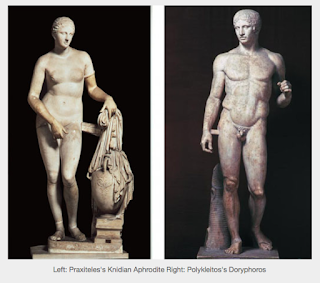The Body in Art History
The Classical Period in art covers the Greek and Roman culture. Classical Greek art is generally recognized as a visual depiction of the ideal and the real. Figures look perfect, faces are calm and without emotion, bodies look active and they are often nude. Although Ancient Greek art is divided into Archaic, Classical and Hellenistic, the common feature of all is that men are strong and confident and women are shy and innocent. While female sculptures were clothed or draped in togas, males were sculpted carefully till the hair of their genitals.
Most scholars shun the idea that a realistic pubis was seen as aesthetically unappealing, and the most prominent theories today center around female genitalia being viewed as sexually aggressive. Women being aggressive, let alone sexually aggressive, was heavily discouraged and punished in Greek society. *
The fact that male nudity is very common alongside female nudity reflects Greek ideas on gender. For a man to appear naked was seen as his power, his strong body and intelligence, while for a woman being naked would be indecent and impure.
It is important to remember that as other working members of Classical Greek society, the artists were mainly men as well. Unfortunately, women in the art history in Ancient Greece shaped by male perspective. According to Sue Blundell, “Both as a group and as individuals, the women of Ancient Greece are to a large extent creatures who have been invented by men.”
In the Medieval Period, the culture characterized by the feudalism and controlling power of the Catholic Church in the people’s lives. Medieval art showed itself in religious subjects. Flat, two-dimensional figures were shown by fully clothed. Faces were divine with the little emotions. There were no interest to create realistic space as a background, therefore only single color, mostly gold, used at behind the figures. The human body was less important than the spiritual sense.
Moving on to Renaissance Art, it was, in many ways, ‘rebirth’ of the Ancient culture and philosophy. Literature, architecture and art influenced by nature and naturalism. Both religious and nonreligious scenes were displayed. Figures looked idealized, bodies were active and moving. There were more facial expressions and more natural details.
Women were the common subjects within Renaissance art forms. Nudity and sexuality were the predominant aspects of the female subjectiveness. In addition to these, women represented in artworks as virtuous wife with childlike innocence, yet at the same time, a desirable object. This means that art forms didn’t reflect the realities of the Italian society, but showed the social ideals and values.
The ‘ideal’ was being chubby for women, and athletic for men. If we look from the female side, being chubby meant being wealthy. Having long hair and wide hips indicated that the woman was more fertile. On the other hand, the ideal man in Renaissance art looked athletic, healthy, fit but not too muscular. The man should had been educated, intellectual and he also should had taken care of himself.
Although I seem to be moving from a completely different topic, I think the Pin-Up Girls and female representation in 1800s has a very close relationship to Ancient and Renaissance Art gender perspectives.
The origin of the Pin-Up Girl came from Gibson Girl. Charles Dana Gibson illustrated the covers of Life magazine inspired by his wife and family in the 1985. Gibson Girl became a national icon that America loved. She was the first “dream girl”, pinning her photo up on your wall.
“…the original "Gibson Girls" and the models for the drawings that changed the way America thought about women.
Though the 1890s may seem buttoned up by modern standards, they were anything but, independent, well-read, and urbane, a new class of woman was emerging in America's cities. This "New Woman" did not care to be chaperoned in public. She was athletic and free-spirited. Above all, she was educated, taking advantage of new access to secondary school and college.” **
During the World War II, pinups carefully designed by the U.S. Government to raise morale of army by representing sexy girls-the girls worth fighting for. Pinups had golden age during the World War II, because US soldiers couldn't go anywhere without seing a pin-up girl. They taped to submarine walls, pinned in barracks. Soon the erotic tactics prepared for war advertising were extended to all advertising…
States, policies and some social norms have more power to speak about our body than we do. For a long time, the body has been portrayed as idealized, sometimes even designed, rather than visualize it in natural state.
Over time, the state delegated the control mechanism to companies. The power practice that supervises, regulates and watches people has been monopolized by companies. We have learned to be "normal", healthy and fit, heterosexual, active and regular. When the centralized power or micro-powers detects that we are abnormal, then they rehabilitate us, normalize us.
According to Foucault, society is under the pressure of power in their daily routines, even in their bodies. He implied that the body first came under the domination of church, then capitalism and political corporation. The power expects from individuals to be productive in term of labor force. Therefore, differences are disappear, objectivity come into prominence.
Over time, the state delegated the control mechanism to companies. The power practice that supervises, regulates and watches people has been monopolized by companies. We have learned to be "normal", healthy and fit, heterosexual, active and regular. When the centralized power or micro-powers detects that we are abnormal, then they rehabilitate us, normalize us.
According to Foucault, society is under the pressure of power in their daily routines, even in their bodies. He implied that the body first came under the domination of church, then capitalism and political corporation. The power expects from individuals to be productive in term of labor force. Therefore, differences are disappear, objectivity come into prominence.






Yorumlar
Yorum Gönder